In 2019, the Texas Legislature passed historic school finance legislation to help schools identify these children and provide them the support they need. House Bill 3 assigns every census block group a “tier” based on its level of economic need, then uses that data to allocate additional funding to public school students from the most disadvantaged neighborhoods in the Lone Star State.
Five years later, it’s time to answer a crucial question. Where are those dollars making an impact?
To our knowledge, no one has used this data to analyze students’ academic outcomes by their specific level of economic need — until now. We find that public charter schools are particularly effective at paving the way to future success for the state’s highest-need students.
In 2019, the Texas Legislature passed historic school finance legislation to help schools identify these children and provide them the support they need. House Bill 3 assigns every census block group a “tier” based on its level of economic need, then uses that data to allocate additional funding to public school students from the most disadvantaged neighborhoods in the Lone Star State.
Five years later, it’s time to answer a crucial question. Where are those dollars making an impact?
To our knowledge, no one has used this data to analyze students’ academic outcomes by their specific level of economic need — until now. We find that public charter schools are particularly effective at paving the way to future success for the state’s highest-need students.



Traditionally, economic disadvantage in schools has been measured by eligibility for free or reduced-price lunch alone. This paints an incomplete picture. Students with a wide range of household incomes qualify for these programs — but a child facing deep poverty requires more support than someone living just below the poverty line.
House Bill 3 recognized these degrees of need for the first time. It provides additional funding to public schools for every student eligible for free or reduced-price lunch, but the amount increases along a sliding scale based on where the student lives.
Here’s how that works:
Traditionally, economic disadvantage in schools has been measured by eligibility for free or reduced-price lunch alone. This paints an incomplete picture. Students with a wide range of household incomes qualify for these programs — but a child facing deep poverty requires more support than someone living just below the poverty line.
House Bill 3 recognized these degrees of need for the first time. It provides additional funding to public schools for every student eligible for free or reduced-price lunch, but the amount increases along a sliding scale based on where the student lives.
Here’s how that works:






These funds go a long way toward providing support such as tutoring, access to technology, and counseling. This system also gives us visibility into the true picture of economic disadvantage at every public school — a valuable tool for assessing student needs. Texas is among the first states in the country to adopt this kind of approach for all school districts.
These funds go a long way toward providing support such as tutoring, access to technology, and counseling. This system also gives us visibility into the true picture of economic disadvantage at every public school — a valuable tool for assessing student needs. Texas is among the first states in the country to adopt this kind of approach for all school districts.
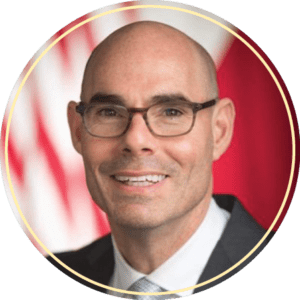
“One reason I’m so proud of House Bill 3 is that it helps Texas identify and support students with the greatest need while helping break the cycle of generational poverty.
Children growing up in poverty rely on public schools to help them realize their full potential and achieve security for themselves and their families. The more we do that, the more we can change the trajectory not only of the individual students, but also their families and communities.”
Dennis Bonnen, former Speaker of the Texas House
“One reason I’m so proud of House Bill 3 is that it helps Texas identify and support students with the greatest need while helping break the cycle of generational poverty.
Children growing up in poverty rely on public schools to help them realize their full potential and achieve security for themselves and their families. The more we do that, the more we can change the trajectory not only of the individual students, but also their families and communities.”
Dennis Bonnen, former Speaker of the Texas House
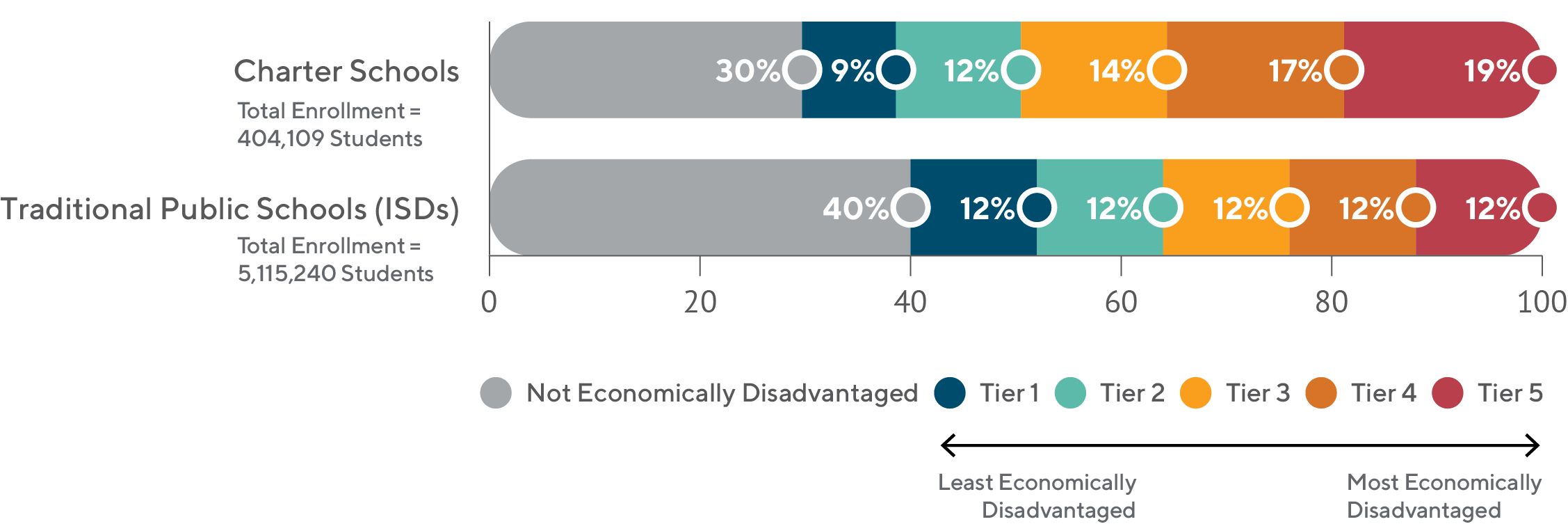
At public charter schools, 36% of students live in the state’s lowest-income neighborhoods. That compares to 24% at traditional public schools.
At public charter schools, 36% of students live in the state’s lowest-income neighborhoods.
That compares to 24% at traditional public schools.
You might wonder whether this difference results from the fact that public charter schools are disproportionately located in urban areas with higher poverty rates. But the data provides a different explanation. The lowest-income families in Texas are simply more likely to choose public charter schools — many of which were created and designed to meet those families’ needs.
Even within the same metropolitan areas, public charter schools nearly always enroll larger shares of the lowest-income students. This includes double-digit gaps in Houston, Dallas-Fort Worth, and Austin, as well as many smaller metro areas.
You might wonder whether this difference results from the fact that public charter schools are disproportionately located in urban areas with higher poverty rates. But the data provides a different explanation. The lowest-income families in Texas are simply more likely to choose public charter schools — many of which were created and designed to meet those families’ needs.
Even within the same metropolitan areas, public charter schools nearly always enroll larger shares of the lowest-income students. This includes double-digit gaps in Houston, Dallas-Fort Worth, and Austin, as well as many smaller metro areas.
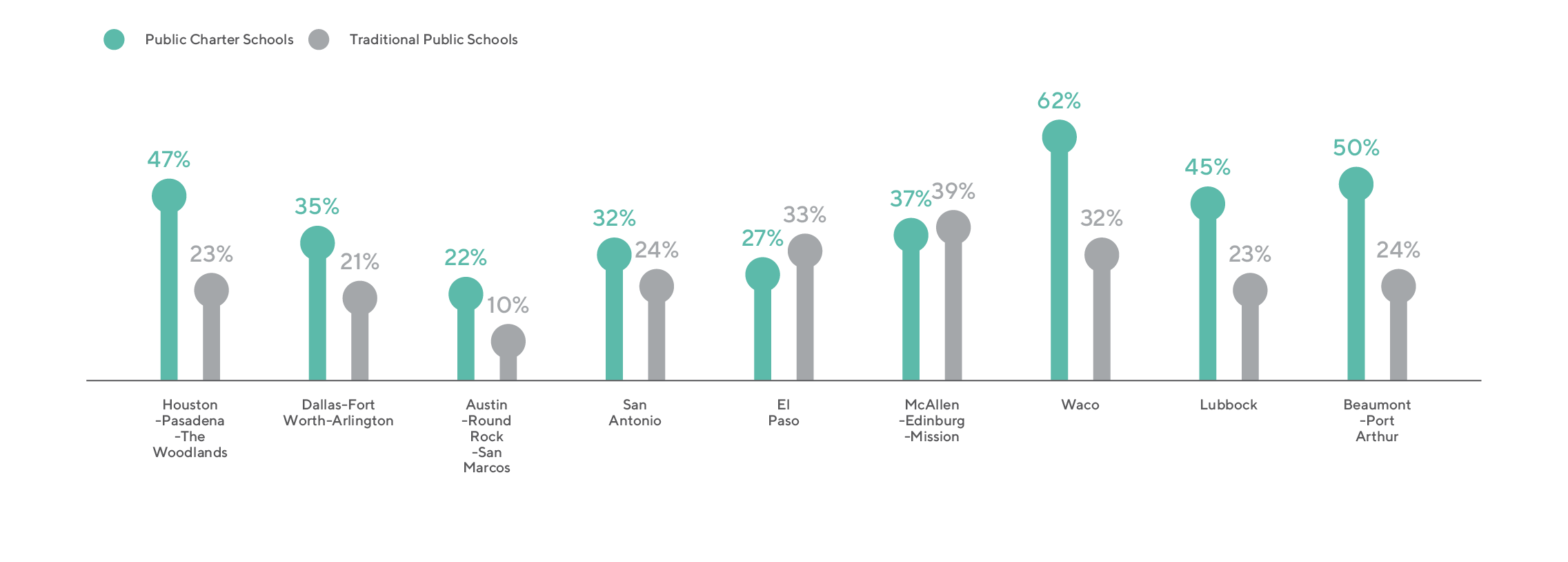
Across almost every grade level and subject, Tier 4 and 5 public charter school students are outperforming their peers at traditional public schools statewide. This is especially pronounced in high school end-of-course assessments, with double-digit gaps in Biology, English I, and English II.4
Strikingly, public charter school students from the most profoundly disadvantaged neighborhoods are completing advanced coursework at nearly double the rate of their peers at traditional public schools statewide (78% vs. 41%).
They’re also three times as likely to pass rigorous Advanced Placement and International Baccalaureate exams (42% vs. 13%).1
Across almost every grade level and subject, Tier 4 and 5 public charter school students are outperforming their peers at traditional public schools statewide. This is especially pronounced in high school end-of-course assessments, with double-digit gaps in Biology, English I, and English II.4
Strikingly, public charter school students from the most profoundly disadvantaged neighborhoods are completing advanced coursework at nearly double the rate of their peers at traditional public schools statewide (78% vs. 41%).
They’re also three times as likely to pass rigorous Advanced Placement and International Baccalaureate exams (42% vs. 13%).1
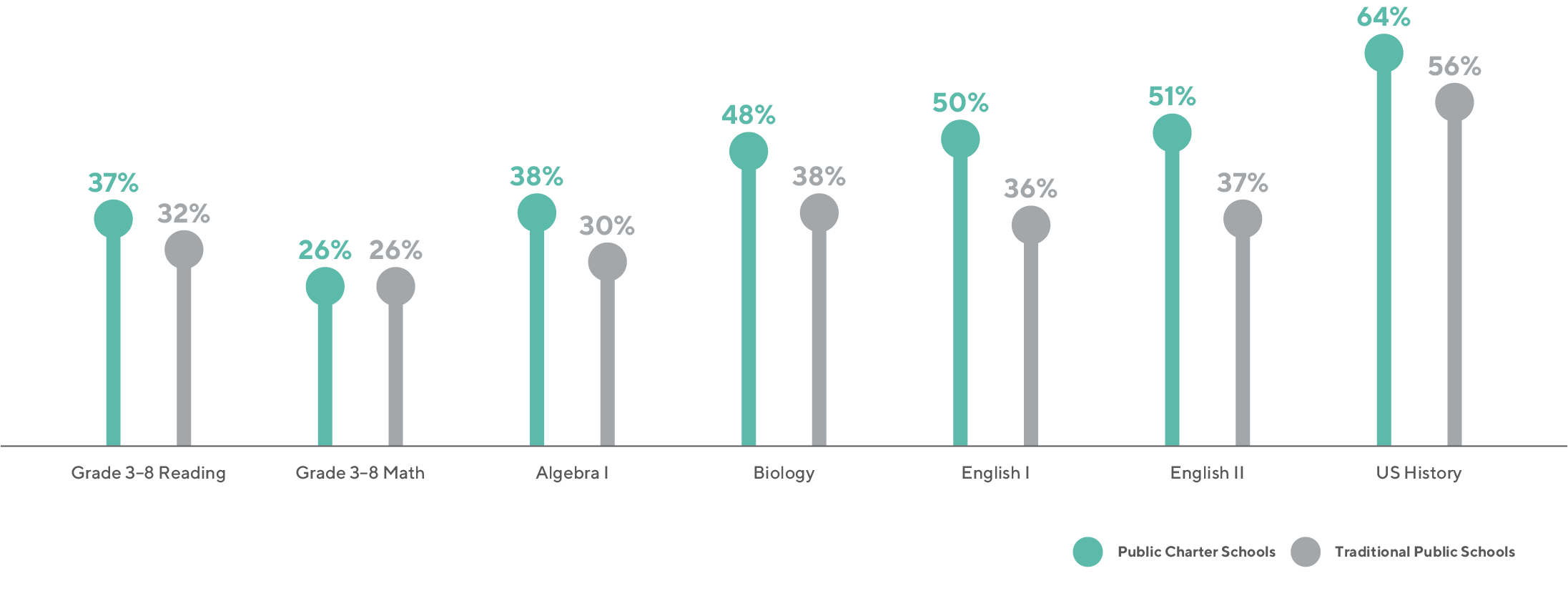

“As lawmakers, it’s incumbent upon us to guarantee that every child in Texas, particularly those with the greatest needs, have access to a toptier education. Public charter schools are instrumental in fulfilling that commitment.”
Texas Rep. Brad Buckley
House Public Education
Committee Chairman
“As lawmakers, it’s incumbent upon us to guarantee that every child in Texas, particularly those with the greatest needs, have access to a top-tier education. Public charter schools are instrumental in fulfilling that commitment.”
Texas Rep. Brad Buckley
House Public Education
Committee Chairman

“As lawmakers, it’s incumbent upon us to guarantee that every child in Texas, particularly those with the greatest needs, have access to a top-tier education. Public charter schools are instrumental in fulfilling that commitment.”
Texas Rep. Brad Buckley
House Public Education
Committee Chairman
Public charter schools are helping more of the state’s highest-need students not only access these courses, but succeed in them. The impact is dramatic. While around three-quarters of both public charter schools and traditional public high schools offer AP and IB courses, a significantly higher rate of public charter school students are succeeding on the exams.
There are 104 public charter high schools included in our analysis.2 At 56 of them, the percentage of Tier 4 and 5 students who pass an AP or IB exam is triple the statewide average for traditional public schools (39% vs. 13%). That’s nearly as many as all other public high schools combined (63).
If we focus on non-selective schools, excluding magnet programs where enrollment criteria are applied, the difference is even clearer. In fact, 41 of the top 50 non-selective public high schools in terms of AP and IB success are charter schools.
Public charter schools are helping more of the state’s highest-need students not only access these courses, but succeed in them. The impact is dramatic. While around three-quarters of both public charter schools and traditional public high schools offer AP and IB courses, a significantly higher rate of public charter school students are succeeding on the exams.
There are 104 public charter high schools included in our analysis.2 At 56 of them, the percentage of Tier 4 and 5 students who pass an AP or IB exam is triple the statewide average for traditional public schools (39% vs. 13%). That’s nearly as many as all other public high schools combined (63).
If we focus on non-selective schools, excluding magnet programs where enrollment criteria are applied, the difference is even clearer. In fact, 41 of the top 50 non-selective public high schools in terms of AP and IB success are charter schools.



Graduates from Texas public charter schools are more likely than their peers statewide to graduate prepared for college, career, or the military. This holds true for both standard3 and dropout recovery high schools.4
Public charter schools are also opening the door to college for more of the highest-need students. Statewide, about 48% of all high school graduates enroll in a postsecondary degree program at an institute of higher education. For students in the most profoundly disadvantaged neighborhoods (Tiers 4 and 5), that rate is only 35%.
However, at Texas public charter schools, students in the most profoundly disadvantaged neighborhoods are enrolling in college 49% of the time — exceeding the overall statewide performance for all students.4
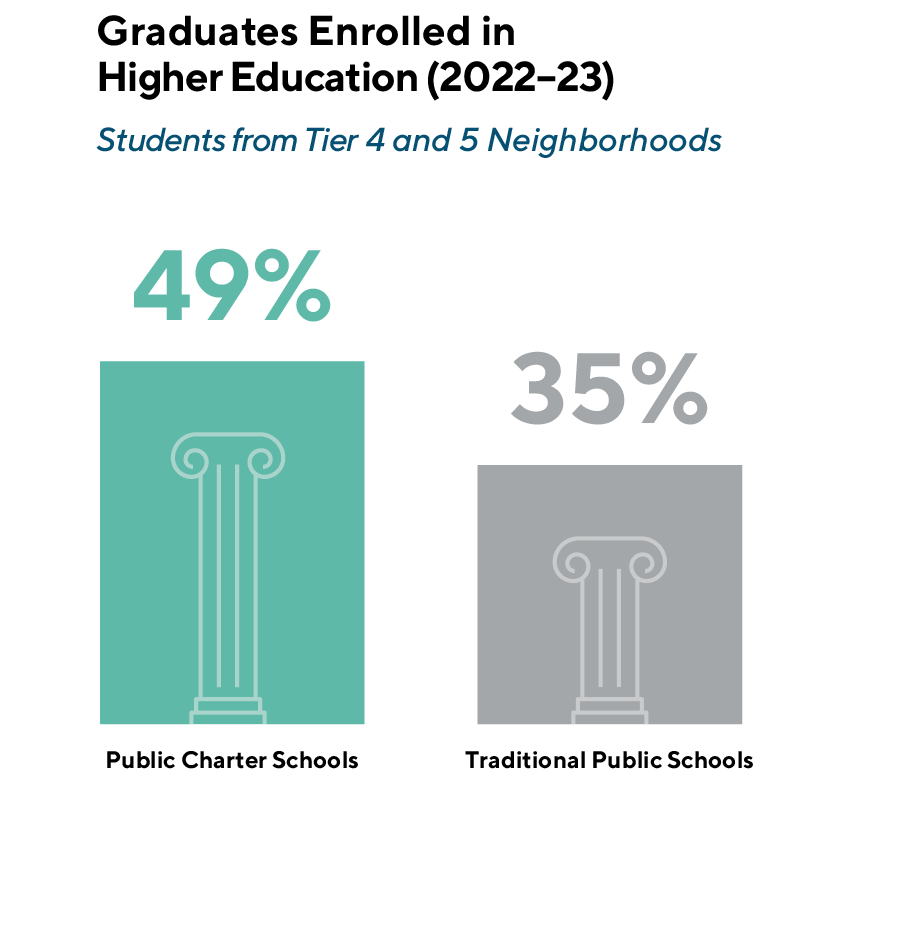
Public charter schools are helping more of the state’s highest-need students not only access these courses, but succeed in them. The impact is dramatic. While around three-quarters of both public charter schools and traditional public high schools offer AP and IB courses, a significantly higher rate of public charter school students are succeeding on the exams.
There are 104 public charter high schools included in our analysis.2 At 56 of them, the percentage of Tier 4 and 5 students who pass an AP or IB exam is triple the statewide average for traditional public schools (39% vs. 13%). That’s nearly as many as all other public high schools combined (63).
If we focus on non-selective schools, excluding magnet programs where enrollment criteria are applied, the difference is even clearer. In fact, 41 of the top 50 non-selective public high schools in terms of AP and IB success are charter schools.
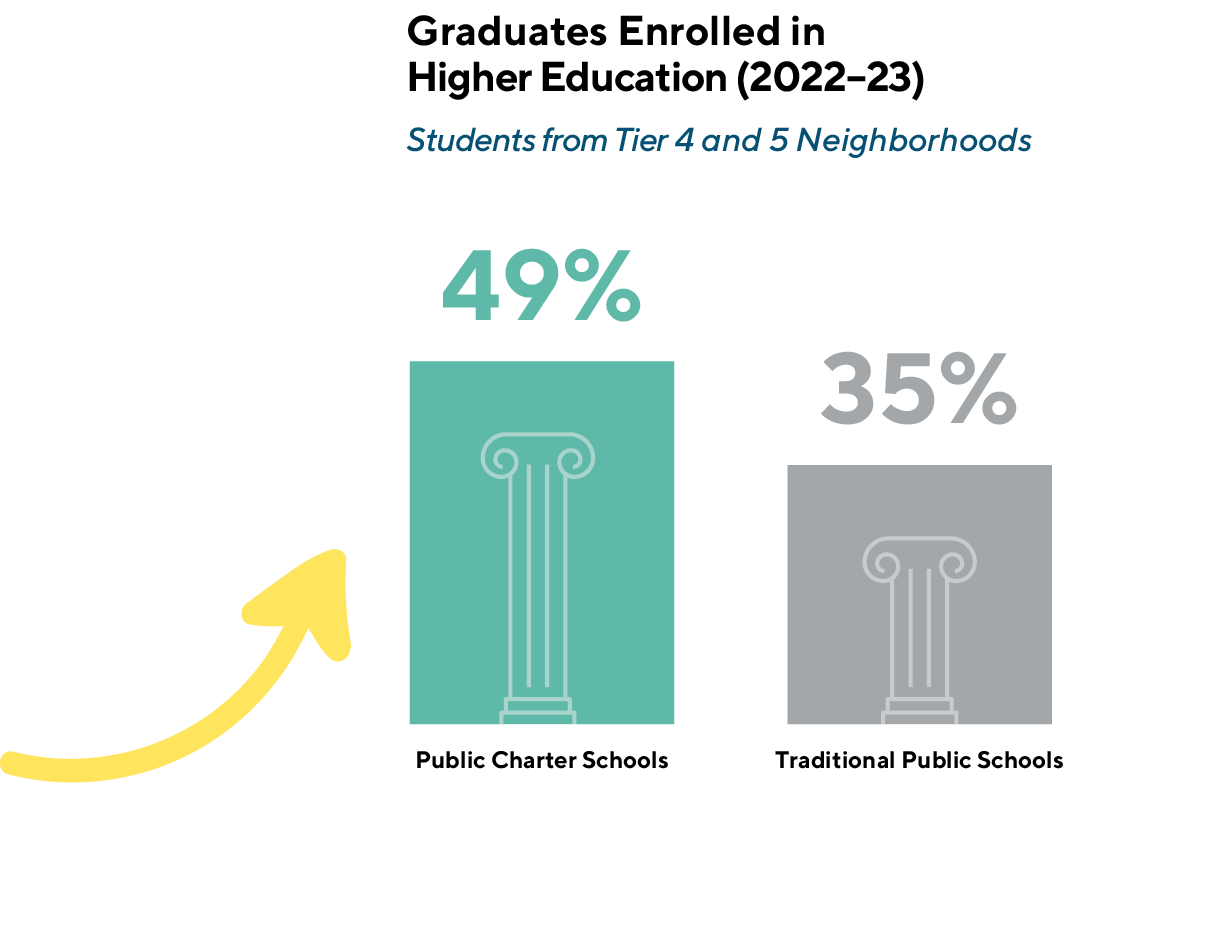


Questions? Contact: research@txcharterschools.org
Questions? Contact: research@txcharterschools.org
1. TEA Public Information Request: TAPR 2022-23 Data disaggregated for Tier 4 and 5 students in standard accountability schools
2. TEA Public Information Request: TAPR 2022-23 Data disaggregated for Tier 4 and 5 students in standard accountability schools.
Note: Around 25% of both public charter schools and traditional public schools offering AP/IB were masked due to small counts of participating students.
3. TEA Public Information Request: TAPR 2022-23 Data disaggregated for Tier 4 and 5 students in standard accountability schools
4. TEA Public Information Request: TAPR 2022-23 Data disaggregated for Tier 4 and 5 students in alternative accountability schools